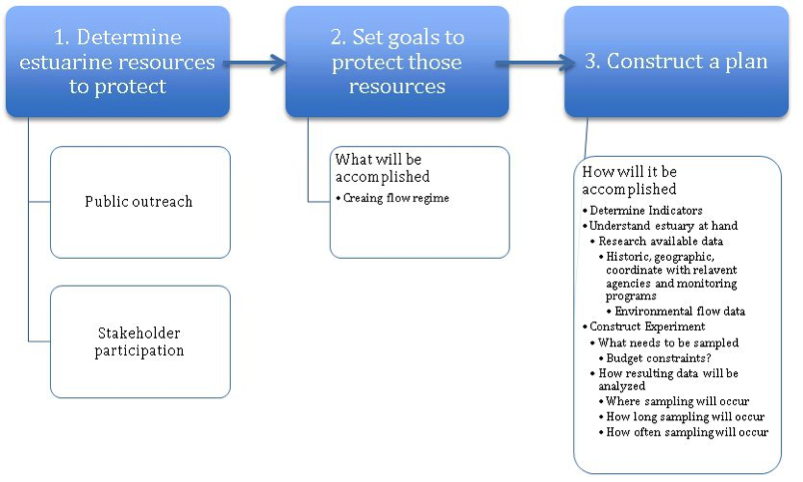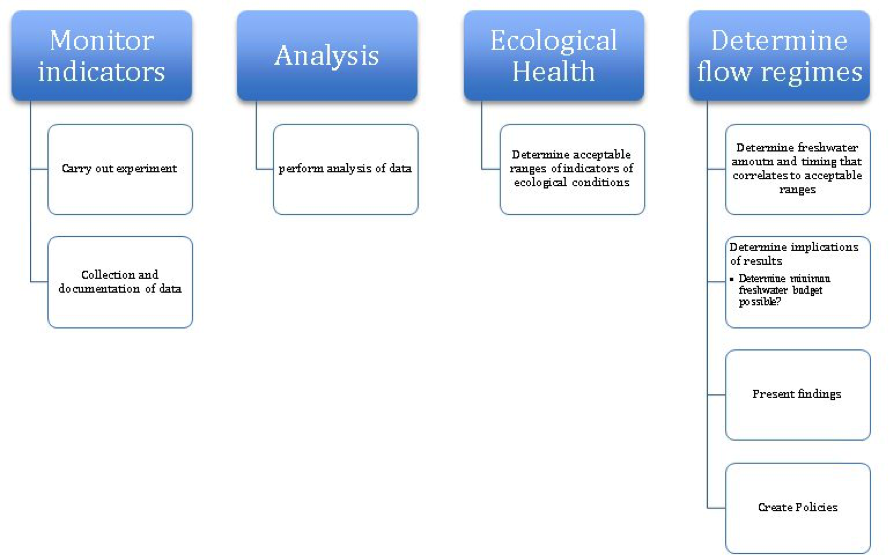For FIT to be as useful as possible to managers, it has been modeled using ecosystem based management concepts. Effective estuarine ecosystem based management strategies require a broad approach to analyzing information and making management decisions. Integration of a broad range of data, information, human components, and technology into useful management tools will create effective strategies for managing freshwater inflows and protecting estuarine habitats.
The type of ecosystem management requiring a comprehensive approach to incorporate land, energy, and natural resource use and allocation involving species management, natural commodities, and humans as components is referred to as ecosystem-based management (EBM) strategies (Arkema et al. 2006). EBM also incorporates data analyzing various interactions over different amounts of time and space. This may be directed at the maintenance or enhancement of the entire riverine ecosystem, including its various aquatic and riparian biota and components from source to sea (Tharme 2003).
The purpose of using EBM strategies is to be able to use the information learned from your plan to achieve main goal of that plan. The purpose of determining freshwater inflow regimes is ultimately to maintain or restore a sustainable estuary. A sustainable estuary is one that is able to continue to be productive, providing resources in the mist of increases anthropogenic demands and resisting degradation and invasive species. To do this, a freshwater inflow regime can be determined, next it has to be accepted as valid, and then reasonable and enforceable regulations to fulfill that regime using ecosystem-based management strategies must be implemented.
To develop the plan, the resources to be protected must first be identified. The resource of interest may very well depend on the values that the community holds as well as the agencies budget. Stakeholder engagement meetings to identify these resources should be done. The most important consideration when planning which resource is the ability to fundamentally link that resource to the estuary. The critical habitat of the resource of interest should therefore be identified; this will be the estuarine area the freshwater inflow regime will be determined for.
It is important to research all historic and current information available including information on how other areas are addressing freshwater inflow concerns and data available by different agencies for the estuary of interest to create a baseline for comparison for current or future changes that may occur.
Once research and agency coordination has been considered, the next step is to determine the goals of the strategy. Consider the questions you want to answer. The main goal for CDFIG is to create freshwater inflow regimes using EBM. Consider what you would like to accomplish by creating EBM strategies regarding freshwater inflows. Be aware of how to implement the plan through policy procedures.
The following tables show the steps to developing ecosystem-based management plans using the information provided through CDFIG.

The construction of the plan will include how you are actually going to accomplish the goals you have set out. After these steps, the plan can be implemented. The plan is essential because it is only useful if it is applicable to answering the questions you have. Know how you’re going to analyze the data. The plan you create may very well bring up more questions than answers but if planned correctly, those changes can be more easily addressed.
The following tables show the steps for implementing ecosystem-based management plans using the information provided through CDFIG.

Resources for ecosystem-based management strategies:
- SeaWeb provides information on Ecosystem based management strategies including definitions, benefits of ecosystems, implementing EBM, communicating EBM, tools fro communicating EBM, and SeaWeb’s outreach projects.